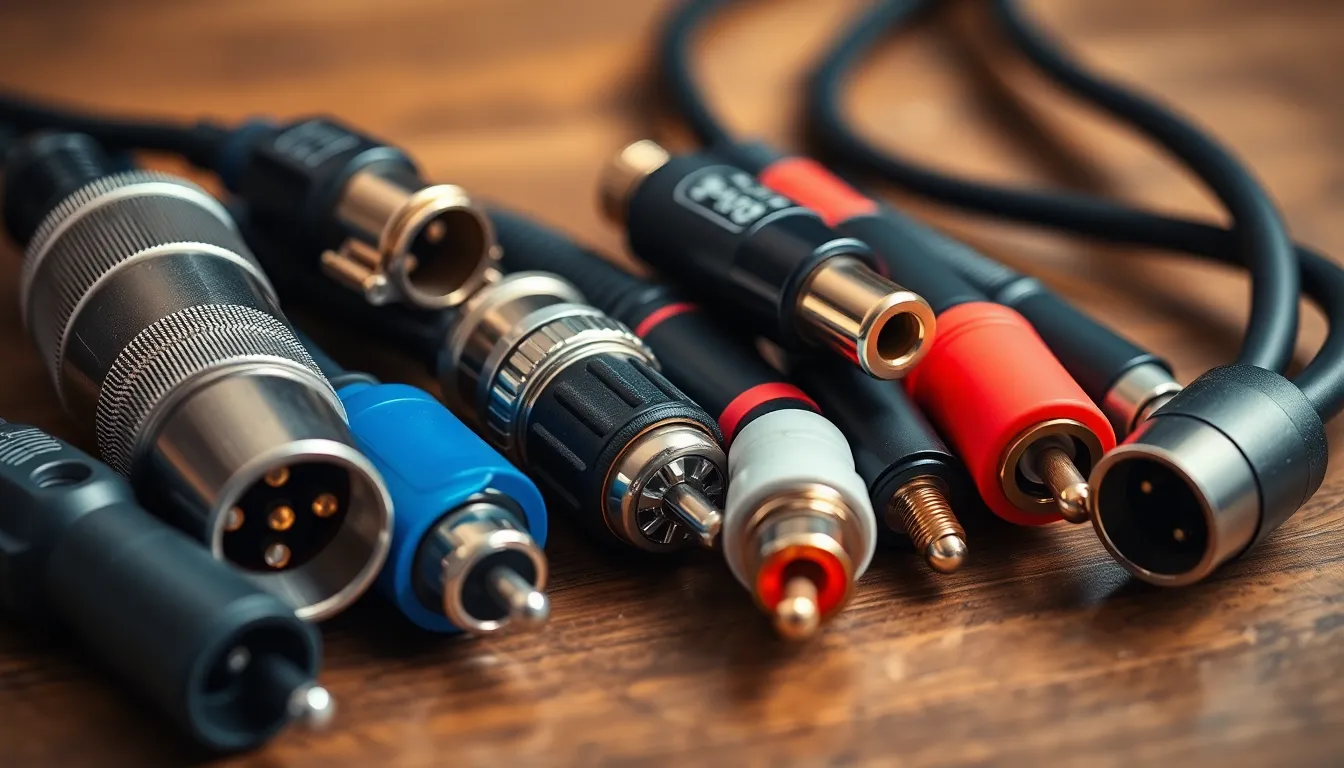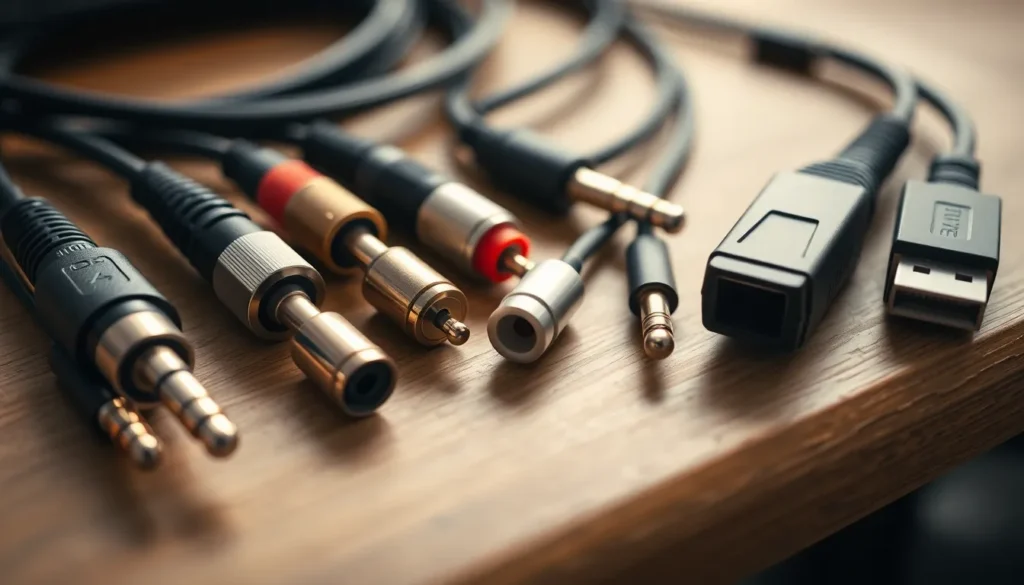In a world where sound reigns supreme, audio connectors are the unsung heroes behind every epic playlist and movie moment. These little gadgets might not have the star power of a celebrity, but they’re the backbone of any audio setup, ensuring that your favorite tunes come through loud and clear. Without them, you’d be left with nothing but silence—and let’s be honest, nobody wants that.
Table of Contents
ToggleOverview of Audio Connectors
Audio connectors play a vital role in delivering quality sound in various applications. They ensure seamless communication between devices, making enjoyable listening experiences possible.
Types of Audio Connectors
Numerous audio connectors exist, each serving specific functions. Common types include 3.5mm jacks, which connect headphones and portable devices. RCA connectors, often found in home audio systems, transmit stereo sound. XLR connectors, typically used in professional settings, provide balanced audio signals to reduce noise. Optical connectors, meanwhile, transmit digital audio, ensuring high fidelity. Lastly, USB connectors are widespread in computers and modern devices, facilitating audio data transfer.
Common Uses of Audio Connectors
Audio connectors find applications in various settings. Headphones utilize 3.5mm jacks for personal audio enjoyment. Home theater systems employ RCA connectors to enhance movie-watching experiences. XLR connectors frequently appear in live sound equipment, ensuring clear audio during performances. Optical connectors enhance digital sound quality for devices like soundbars or gaming consoles. USB connectors facilitate connections between computers and audio interfaces, streamlining recording processes. These connectors ensure that audio devices interact effectively, delivering superior sound quality.
Popular Audio Connectors

Different audio connectors serve unique functions in enhancing sound quality. Understanding these connectors helps users select the right ones for various applications.
XLR Connectors
XLR connectors primarily serve professional audio applications. Typically featuring three pins, they provide balanced audio transmission, reducing interference and noise. Musicians often use these connectors for microphones and other studio equipment. Cable reliability increases due to their secure locking mechanism, ensuring connections during live performances. Generally, XLR connectors enhance overall sound quality in professional environments.
TRS and TS Connectors
TRS and TS connectors play important roles in audio equipment connections. TRS, or Tip-Ring-Sleeve connectors, support balanced audio and stereo signals. Users commonly find them in headphones and instruments like guitars. TS, or Tip-Sleeve connectors, primarily transmit unbalanced mono signals. These are typically used for electric guitars and basic audio devices. Knowing the difference between TRS and TS aids in achieving the best sound quality.
RCA Connectors
RCA connectors remain popular for home audio and video systems. Characterized by their color-coded plugs, red and white RCA connectors transmit stereo audio, while yellow connectors handle composite video. Home theater enthusiasts often utilize these connectors for DVD players, game consoles, and televisions. The simplicity of RCA connectors makes them easy to connect and disconnect, making them ideal for casual users.
Speakon Connectors
Speakon connectors excel in professional audio setups, particularly for loudspeakers. These connectors feature a locking mechanism to ensure secure connections, preventing accidental disconnections during live events. Designed to handle high power levels, Speakon connectors are ideal for amplifiers and stage monitoring systems. Recognizing their robust design makes them essential for anyone working in live sound or touring environments.
Choosing the Right Audio Connector
Selecting the appropriate audio connector ensures optimal sound quality. Various factors influence this decision, including the specific application and type of equipment used.
Factors to Consider
Sound quality ranks as the top priority when choosing an audio connector. Connector type, the materials used, and frequency response all play significant roles in performance. Durability matters as well; robust connectors withstand wear and tear. The length of the cable should fit the setup to avoid unwanted interference. His or her budget affects choices too, as premium connectors often provide superior sound but come at a higher price.
Compatibility with Devices
Ensuring compatibility with devices is crucial for seamless audio experiences. Check the output and input ports on all equipment before purchasing. Mixed connectors may require adapters, which can impact audio quality. He or she must also consider the type of signals supported by the connectors; analog and digital connectors serve different needs. Each device also may support unique connector types, ranging from 3.5mm jacks to XLR plugs, making it essential to match them appropriately.
Maintaining Audio Connectors
Maintaining audio connectors ensures optimal performance and longevity. Regular attention to these components prevents degradation and signal loss.
Cleaning and Care Tips
Cleaning audio connectors requires specific techniques. First, use a soft cloth or cotton swab to remove dirt and debris. Gentle toothpicks can assist in dislodging stubborn particles. Avoid using abrasive materials that might scratch the surfaces. Regularly check connectors for signs of wear, like fraying or discoloration, which may indicate the need for replacement. If moisture exposure occurs, drying the connectors thoroughly prevents corrosion. Employing contact cleaner can enhance the conductivity of connectors, ensuring quality sound transmission.
Troubleshooting Common Issues
Identifying issues with audio connectors involves several steps. First, listen for audible static or intermittent sound, which often indicates a poor connection. Inspecting the connectors for physical damage can reveal underlying problems. Ensure the connectors firmly attach to devices; loose connections frequently cause sound dropouts. Testing different cables or connectors helps determine the source of the issue. If sound persists on one channel, swapping left and right connectors can help isolate the problem. Finally, checking compatibility between devices can prevent connection issues from arising altogether.
Audio connectors play an indispensable role in achieving high-quality sound across various applications. Their selection directly impacts the listening experience whether it’s for personal enjoyment or professional use. By understanding the different types of connectors and their specific functions users can make informed choices that enhance audio quality.
Proper maintenance and care ensure these connectors remain reliable over time. With the right knowledge and attention to detail users can enjoy seamless audio experiences that bring their favorite music and movies to life. Ultimately investing in the right audio connectors is essential for anyone passionate about sound.

